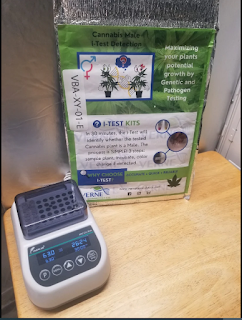Discovery of Hop Latent Viroid Test Kit (HLVd) in Cannabis | Verne Bioanalytics
For a long time, cannabis farmers have been puzzled about the mystery of "duds" among clonal strains.
Hop Latent Viroid Test Kit (HLVd) was recently discovered in cannabis, providing much-needed insight into this time-consuming and frustrating issue. Good sanitation procedures and attention to biosecurity will go a long way toward preventing the spread of HLVd, which is usually disseminated by mechanical means.
Collaboration between Santa Barbara, California's Glass House Farms, and Verne Bioanalytics led to the identification of the Hop Latent Viroid Test Kit (HLVd) in cannabis. Plant Disease is the premier worldwide journal covering novel, emerging, and established plant diseases, and the August 2019 issue will detail our findings and the strategies we used to get here. We verified a second finding after identifying HLVd and doing our tests.
The Issue at Glass House Farms
Graham Farrar, who runs a manufacturing facility just outside of Santa Barbara, California, observed something odd when he checked on his plants: a portion of them had no oil, their heads were little, their leaves were deformed and yellow, and their branches were fragile.
The proprietor of Glass House Farms, Farrar, is a developer who calls himself a "tech geek" and whose resume includes names like SONOS. Although he was a very meticulous gardener, he could not figure out why his plants were ailing despite his efforts. It's strange to see plants all over the place showing signs of illness since our environment is so uniform and controlled automatically.
Curiosity pushed him to pursue research opportunities at academic institutions like UC Davis. He was eventually put in touch with Verne Bioanalytics' CTO, Jes Stahl. The culprit, Hop Latent Viroid Test Kit, was identified via research conducted on the "dead" plants (HLVd).
How to Prevent the Spread of HLVd in Indoor Gardens
Mechanical transmission of the viroid is the primary mode of transmission, with non-sterile pruning tools and scalpels being the most prevalent vectors. Infected instruments may spread the disease by touching plant wounds. It has been established that aphids cannot spread it to hops. While the formation of seeds does not seem to be the predominant mode of transmission, some studies have revealed that HLVd may be spread via seeds at a rate of around 8%.
Preventing the spread of infection by not clipping an infected plant, for example, is a tried-and-true biosecurity measure. Eliminating Testing HPLVD-infected plants as soon as possible is the most effective method for limiting the disease's spread. If the stock plant must be preserved, for example, viruses and viroids may be eradicated using heat and cold treatments of meristem in tissue culture.
Extending Our Knowledge of the Verne Bioanalytics Detection Technique
In February 2018, we extracted RNA from plants that were deemed both ill and healthy at the same lab in Southern California. After that, we sequenced the samples and compared them to one another. Our goal was to identify non-cannabis sequence pieces that were unique to the ill plants and absent in the healthy ones. Consult our published paper for more on how we conducted our experiments.
Thanks to everyone who contributed to this project from several teams! We were only able to shed light on this perplexing problem by combining in-field expertise with laboratory sequencing and subsequent data analysis. Verne Bioanalytics relied heavily on Kristen Waterman and Kayla Hardwick, Ph.D.



Comments
Post a Comment